





 |
 |
 |
 |
 |
 |
|---|---|---|---|---|---|
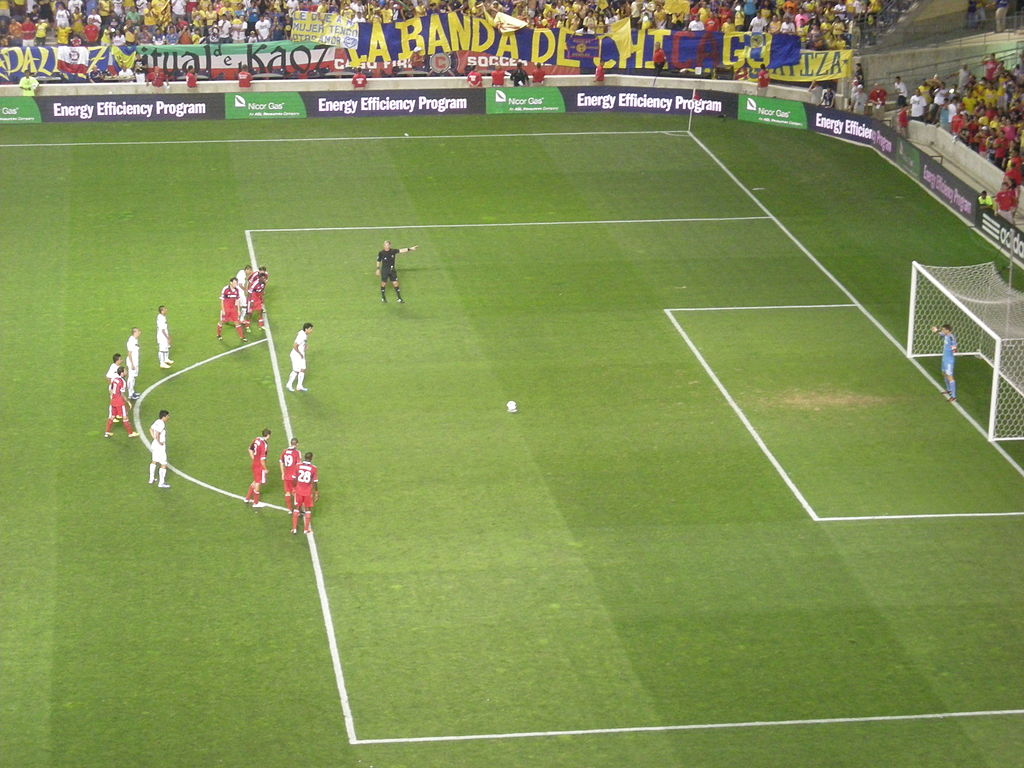 |
|---|
The characteristic distance a ball travels before air slows it down is the "Newton length". This distance can be estimated by setting the mass of the ball is equal to the mass of the air the ball passes through.
Mass of a soccer ball = M = .437 kg Ball radius = R = .110 meters Ball cross-sectional area = A = .038 meters2 Ball density = D =78.4 kg/meters3 Air density = d = 1.22 kg/meter3 (Air at sea level) Ball initial velocity = V Newton length = L Mass of air the ball passes through= m = A L d m = M L = M / (A d) = (4/3) R D / d = 9.6 metersThe depth of the penalty box is 16.45 meters (18 yards). Any shot taken outside the penalty box slows down substantially before reaching the goal.
Newton was also the first to observe the "Magnus effect", where spin causes a ball to curve.
 |
|---|
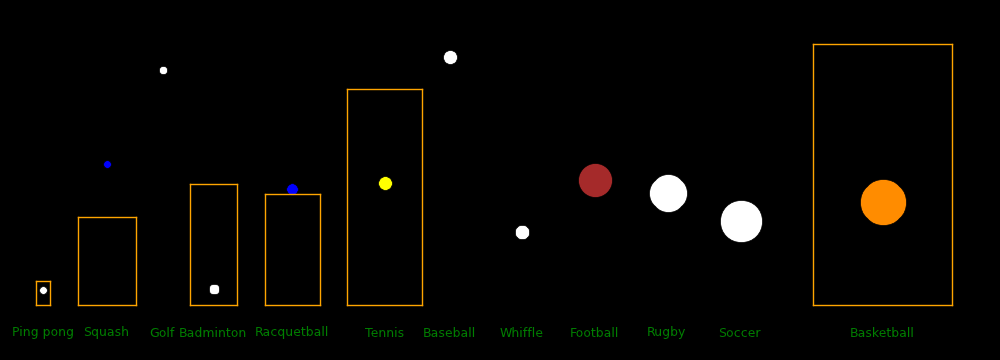 |
|---|
The orange boxes depict the size of the court and the Newton length is the distance from the bottom of the court to the ball. Ball sizes are magnified by a factor of 20 relative to the court sizes.
Diameter Mass Drag Shot Drag/ Density Ball Max Spin
(mm) (g) (m) (m) Shot (g/cm3) speed speed (1/s)
(m/s) (m/s)
Ping pong 40 2.7 1.8 2.74 .64 .081 20 31.2 80
Squash 40 24 15.6 9.75 1.60 .716
Golf 43 46 25.9 200 .13 1.10 80 94.3 296
Badminton 54 5.1 1.8 13.4 .14 .062
Racquetball 57 40 12.8 12.22 1.0 .413
Billiards 59 163 48.7 2.7 18 1.52
Tennis 67 58 13.4 23.77 .56 .368 50 73.2 119
Baseball 74.5 146 27.3 19.4 1.4 .675 40 46.9 86
Whiffle 76 45 8.1 .196
Football 178 420 13.8 20 .67 .142 20 26.8 18
Rugby 191 435 12.4 20 .62 .119
Bowling 217 7260 160 18.29 8.8 1.36
Soccer 220 432 9.3 16.5 .56 .078 40 29
Basketball 239 624 11.4 7.24 1.57 .087
Cannonball 220 14000 945 1000 .94 7.9
"Drag" is the Newton drag length and "Shot" is the typical distance of a shot, unless otherwise
specified. "Density" is the density of the ball.
For a billiard ball, rolling friction is greater than air drag.
A bowling pin is 38 cm tall, 12 cm wide, and has a mass of 1.58 kg. A bowling ball has to be sufficiently massive to have a chance of knocking over 10 pins.
Mass of 10 bowling pins / Mass of bowling ball = 2.18
To estimate the distance a bullet travels before being slowed by drag,
Air density = Dair = .012 g/cm3 Water density = Dwater = 1.0 g/cm3 Bullet density = Dbullet = 11.3 g/cm3 Bullet length = Lbullet = 2.0 cm Bullet distance in water = Lwater ≈ Lbullet Dbullet / Dwater ≈ 23 cm Bullet distance in air = Lair ≈ Lbullet Dbullet / Dair ≈ 185 meters
 |
|---|
g/cm3 g/cm3
Air .00122 (Sea level) Silver 10.5
Wood .7 ± .5 Lead 11.3
Water 1.00 Uranium 19.1
Magnesium 1.74 Tungsten 19.2
Aluminum 2.70 Gold 19.3
Rock 2.6 ± .3 Osmium 22.6 (Densest element)
Titanium 4.51
Steel 7.9
Copper 9.0
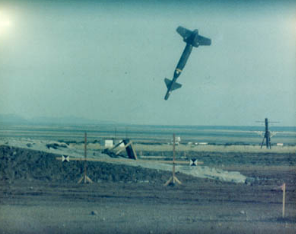 |
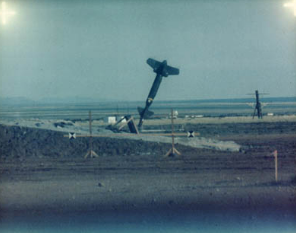 |
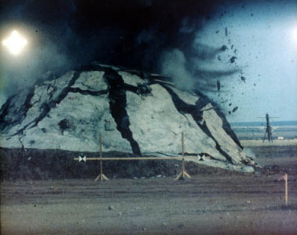 |
|
|---|---|---|---|
Cartridge Projectile Length Diameter Warhead Velocity
(kg) (kg) (m) (m) (kg) (m/s)
Massive Ordnance Penetrator - 13608 6.2 .8 2404
PGU-14, armor piercing .694 .395 .173 .030 1013
PGU-13, explosive .681 .378 .173 .030 1020
The GAU Avenger armor-piercing shell contains .30 kg of depleted uranium.
The massive ordnamce penetrator typically penetrates 61 meters of Earth.
The PGU-13 and PGU-14 are used by the A-10 Warthog cannon.
The composition of natural uranium is .72% uranium-235 and the rest is uranium-238. Depleted uranium has less than .3% of uranium-235.
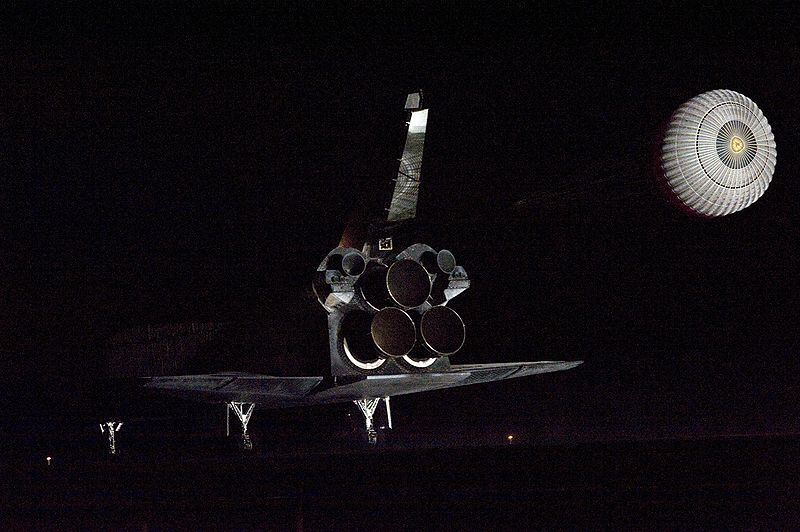 |
|
|---|---|
The drag force on an object moving through a fluid is
Velocity = V Fluid density = D = 1.22 kg/m2 (Air at sea level) Cross-sectional area = A Drag coefficient = C = 1 (typical value) Drag force = F = ½ C D A V2 Drag power = P = ½ C D A V3 = F V Terminal velocity = Vt"Terminal velocity" occurs when the drag force equals the gravitational force.
M g = ½ C D A Vt2Suppose we want to estimate the parachute size required for a soft landing. Let a "soft landing" be the speed reached if you jump from a height of 2 meters, which is Vt = 6 m/s. If a skydiver has a mass of 100 kg then the area of the parachute required for this velocity is 46 meters2, which corresponds to a parachute radius of 3.8 meters.
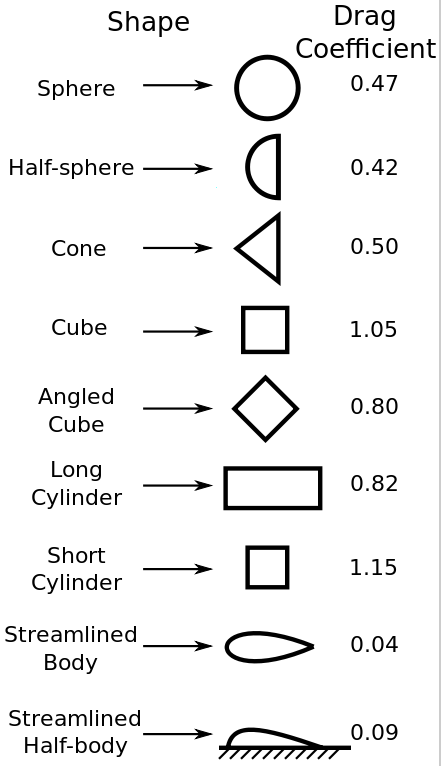 |
|---|
Drag coefficient
Bicycle car .076 Velomobile
Tesla Model 3 .21 2017
Toyota Prius .24 2016
Bullet .30
Typical car .33 Cars range from 1/4 to 1/2
Sphere .47
Typical truck .6
Formula-1 car .9 The drag coeffient is high to give it downforce
Bicycle + rider 1.0
Skier 1.0
Wire 1.2
Mach
X-15 6.7 Rocket
Blackbird SR-71 3.5
X-2 Starbuster 3.2
MiG-25 Foxbat 2.83
XB-70 Valkyrie 3.0
MiG-31 Foxhound 2.83
F-15 Eagle 2.5
Aardvark F-111 2.5 Bomber
Sukhoi SU-27 2.35
F-22 Raptor 2.25 Fastest stealth aircraft
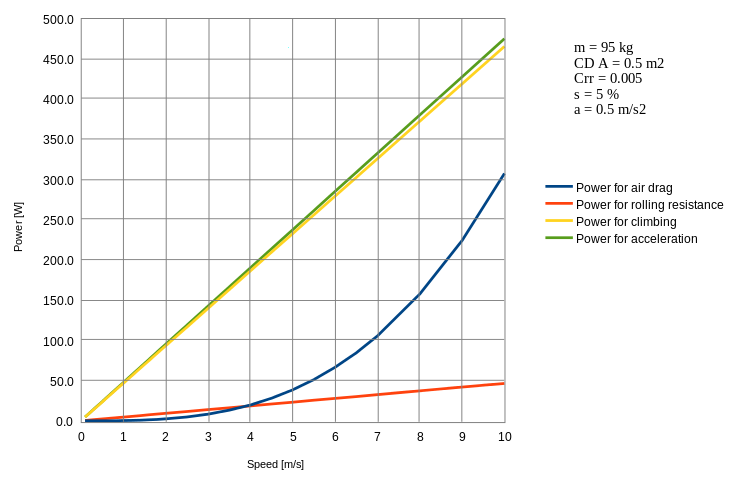 |
|---|
Fluid density = D
Cross section = A
Drag coef = C
Drag force = F = ½ C A D V2
Drag power = P = ½ C A D V3 = K D V3 = F V
Drag parameter = K = ½ C A
Speed Density Drag force Drag power Drag
(m/s) (kg/m3) (kN) (kWatt) parameter
Bike 10 1.22 .035 .305 .50
Bike 18 1.22 .103 1.78 .50
Bike, speed record 22.9 1.22 .160 3.66 .50
Bike, streamlined 38.7 1.22 .095 3.66 .104
Porche 911 94.4 1.22 7.00 661 1.29
LaFerrari 96.9 1.22 7.31 708 1.28
Lamborghini SV 97.2 1.22 5.75 559 1.00
Skydive, min speed 40 1.22 .75 30 .77 75 kg
Skydive, max speed 124 1.22 .75 101 .087 75 kg
Airbus A380, max 320 .28 1360 435200 94.9
F-22 Raptor 740 .084 312 231000 6.8
SR-71 Blackbird 1100 .038 302 332000 6.6
Sub, human power 4.1 1000 .434 1.78 .052
Blue Whale 13.9 1000 270 3750 2.8 150 tons, 25 Watts/kg
Virginia nuclear sub 17.4 1000 1724 30000 11.4
The drag coefficient is an assumption and the area is inferred from the
drag coefficient.
For the skydiver, the minimum speed is for a maximum cross section (spread eagled) and the maximum speed is for a minimum cross section (dive).
Wiki: Energy efficiency in transportation
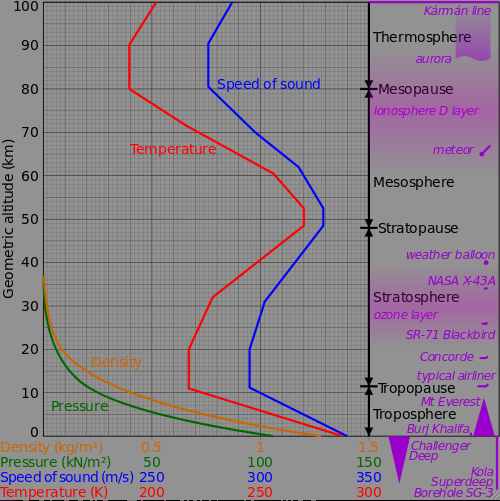 |
|---|
Airplanes fly at high altitude where the air is thin.
Altitude Air density
(km) (kg/m3)
Sea level 0 1.22
Denver (1 mile) 1.6 .85
Mount Everest 9.0 .45
Airbus A380 13.1 .25 Commercial airplane cruising altitude
F-22 Raptor 19.8 .084
SR-71 Blackbird 25.9 .038
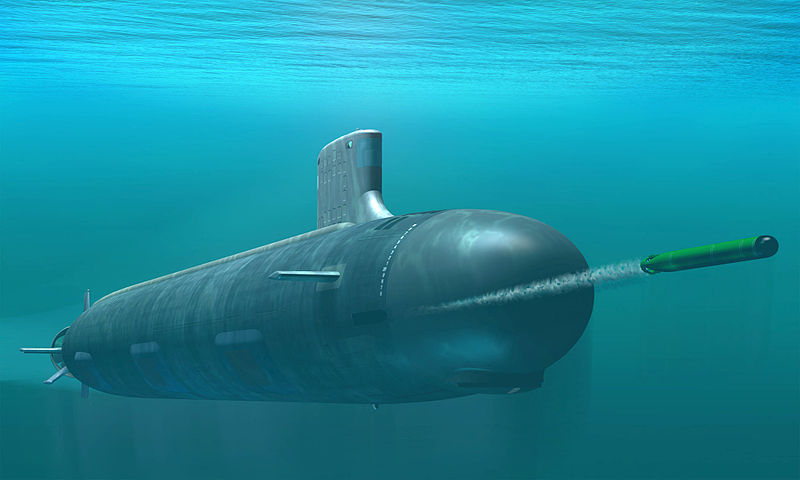 |
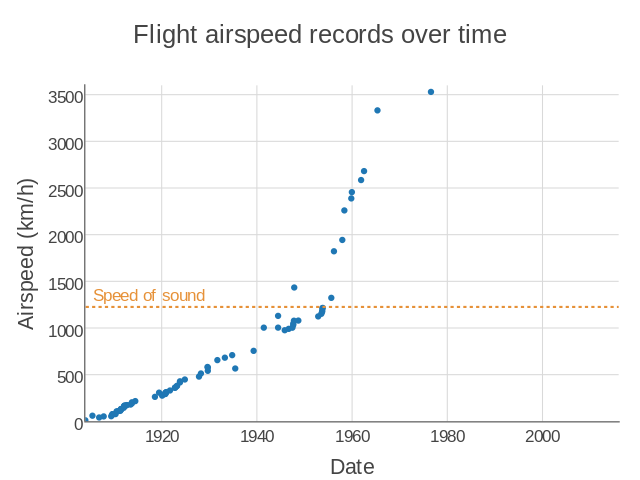 |
|
|---|---|---|
m/s Mach
Swim 2.39
Boat, human power 5.14
Aircraft, human power 12.3
Run 12.4
Boat, wind power 18.2
Bike 22.9
Car, solar power 24.7
Bike, streamlined 38.7
Land animal 33 Cheetah
Bird, level flight 45 White-throated needletail
Aircraft, electric 69
Helicopter 111 .33
Train, wheels 160 .54
Train, maglev 168 .57
Aircraft, propeller 242 .82
Rocket sled, manned 282 .96
Aircraft, manned 981 3.33
Rocket plane, manned 2016 6.83
Rocket sled 2868 9.7
Scramjet 5901 20
Mach 1 = 295 m/s at high altitude.
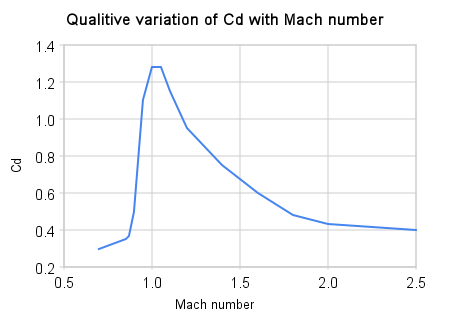 |
|---|
Commercial airplanes fly at Mach .9 because the drag coefficient increases sharply at Mach 1.
The drag coefficient depends on speed.
Object length = L
Velocity = V
Fluid viscosity = Q (Pascal seconds)
= 1.8⋅10-5 for air
= 1.0⋅10-3 for water
Reynolds number = R = V L / Q (A measure of the turbulent intensity)
The drag coefficient of a sphere as a function of Reynolds number is:
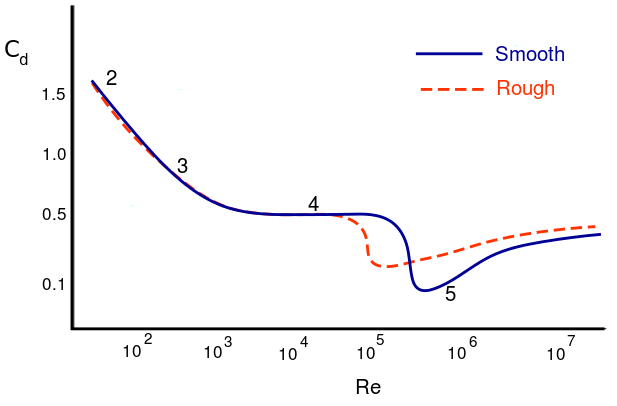 |
|---|
Golf balls have dimples to generate turbulence in the airflow, which increases the Reynolds number and decrease the drag coefficient.
Reynolds Soccer Golf Baseball Tennis number 40000 .49 .48 .49 .6 45000 .50 .35 .50 50000 .50 .30 .50 60000 .50 .24 .50 90000 .50 .25 .50 110000 .50 .25 .32 240000 .49 .26 300000 .46 330000 .39 350000 .20 375000 .09 400000 .07 500000 .07 800000 .10 1000000 .12 .35 2000000 .15 4000000 .18 .30Data
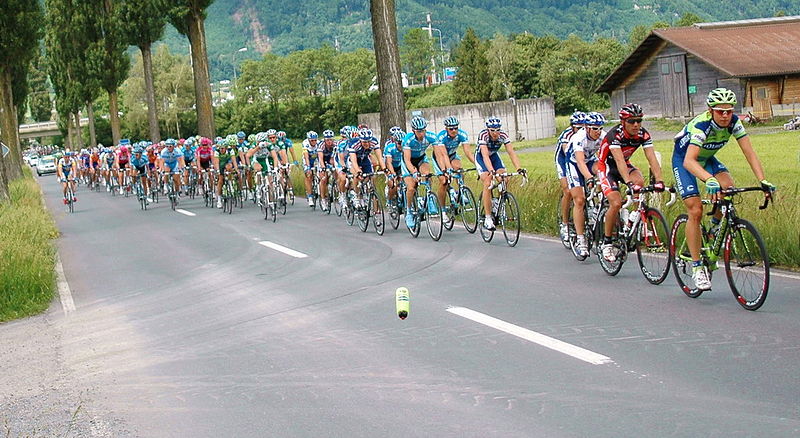 |
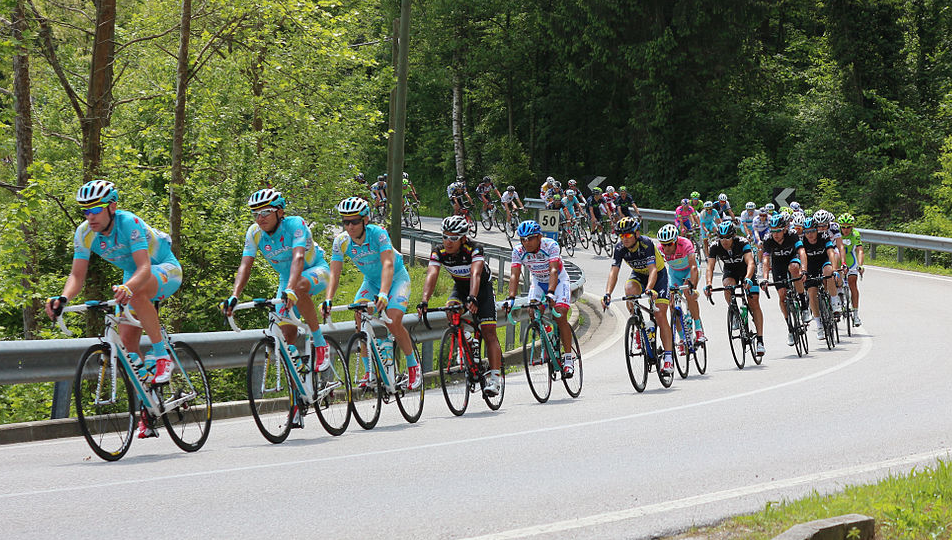 |
|---|---|
If the cyclists are in single file then the lead rider has to use more power than the following riders. Cyclists take turns occupying the lead.
A "slingshot pass" is enabled by drafting. The trailing car drops back by a few lengths and then accelerates. The fact that he is in the leading car's slipstream means he has a higher top speed. As the trailing car approaches the lead car it moves the side and passes.
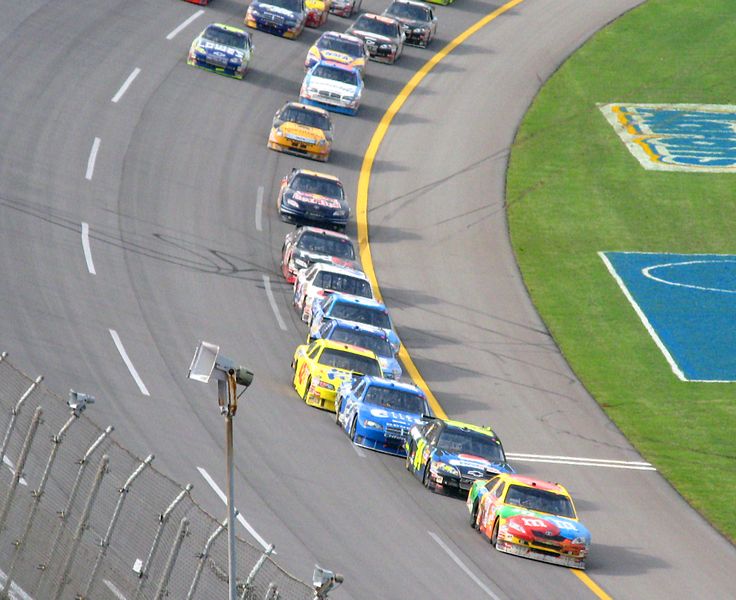 |
 |
|---|---|
For an object experiencing drag,
Drag coefficient = C Velocity = V Fluid density = D Cross section = A Mass = M Drag number = Z = ½ C D A / M Drag acceleration = A = -Z V2 Initial position = X0 = 0 Initial velocity = V0 Time = TThe drag differential equation and its solution are
A = -Z V2 V = V0 / (V0 Z T + 1) X = ln(V0 Z T + 1) / Z
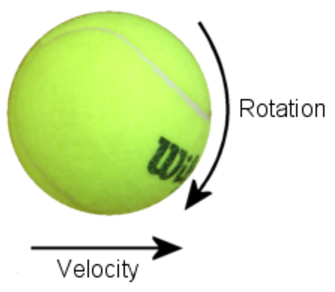 |
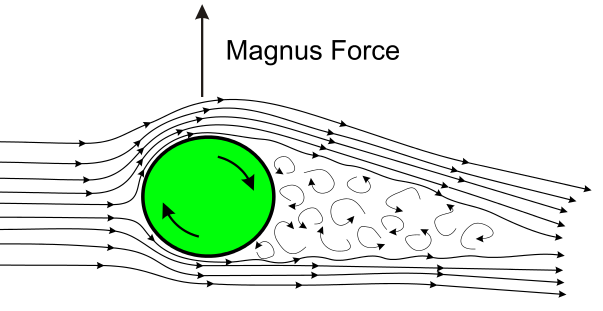 |
|---|---|
1672 Newton is the first to note the Magnus effect while observing tennis players
at Cambridge College.
1742 Robins, a British mathematician and ballistics researcher, explains deviations
in musket ball trajectories in terms of the Magnus effect.
1852 The German physicist Magnus describes the Magnus effect.
For a spinning tennis ball,
Velocity = V = 55 m/s Swift groundstroke Radius = R = .067 m Area = Area = .0141 m2 Mass = M = .058 kg Spin number = S = W R / V = .25 Heavy topspin Spin rate = W = V / R = 205 Hz Air density = Dair = 1.22 kg/m3 Ball density= Dball Drag coef = Cdrag = .5 For a sphere Spin coef = Cspin = 1 For a sphere and for S < .25 Drag force = Fdrag = ½ Cdrag Dair Area V2 = 13.0 Newtons Spin force = Fspin = ½ Cspin Dair Area V2 S = 6.5 Newtons Drag accel = Adrag = 224 m/s2 Spin accel = Aspin = 112 m/s2 Gravity = Fgrav = M gFor a rolling ball the spin number is S=1.
If the spin force equals the gravity force (Fspin = Fgrav),
The drag force on an object moving through a fluid is
The relationship between top speed and engine power is determined by drag.
For human-powered vehicles we assume an athlete with:
If the spin force equals the gravity force (Fspin = Fgrav),
For a typical car,
The drag speed Vd is determined by setting Fr = Fa.
If the cyclists are in single file then the lead rider has
to use more power than the following riders. Cyclists take turns
occupying the lead.
A "slingshot pass" is enabled by drafting. The trailing car drops back by
a few lengths and then accelerates. The fact that he is in the leading car's
slipstream means he has a higher top speed. As the trailing car approaches the
lead car it moves the side and passes.
If everything seems under control, you're just not going fast enough. -- Mario Andretti
I will always be puzzled by the human predilection for piloting vehicles at unsafe
velocities -- Data
Villeneuve vs. Arnoux
At 0:49 Arnoux breaks before he hits the turn.
For maximum cornering acceleration, the same equations apply as for the maximum drag
racing acceleration. It doesn't matter in which direction the acceleration is.
Suppose an object with mass m rests on a ramp inclined by an angle
theta. The gravitational force on the object is
Electric cars outperform gasoline cars in all regards except range. They're
simpler, more powerful, quieter, and more flexible.
The range and power of an electric car depends on the properties of lithium-ion
batteries, and these properties are rapidly improving.
Energy use is proportional to the drag force.
We compare the transport cost per person for various vehicles.
Within cities, cars have faster travel times than buses, especially if parking is
abundant or the cars are self-driving. Buses are more suited to inter-city transport.
Expanded discussion of the drag force.
A typical set of parameters for a racing bike is
We assume a high gear, with 53 teeth on the front gear and 11 teeth on the rear gear.
When going fast the goal of gears is to slow down the pedals.
When one is climbing a hill the goal of gears is to speed up the pedals so that you don't
have to use as much force on the pedals.
Suppose a bike is going uphill at large power and low velocity.
V2 S C R-1 Dair/Dball = .0383

Velocity = V
Fluid density = D = 1.22 kg/m2 (Air at sea level)
Cross-sectional area = A
Drag coefficient = C
Drag force = F = ½ C A D V2
Drag power = P = ½ C A D V3 = F V
Drag parameter = K = C A
"Terminal velocity" occurs when the drag force equals the
gravitational force.
M g = ½ C D A V2
Suppose we want to estimate the parachute size required for a soft landing.
Let a "soft landing" be the speed reached if you jump from a height of 2
meters, which is Vt = 6 m/s. If a skydiver has a mass of 100 kg
then the area of the parachute required for this velocity is 46
meters2, which corresponds to a parachute radius of 3.8 meters.

Drag coefficient
Bicycle car .076 Velomobile
Tesla Model 3 .21 2017
Toyota Prius .24 2016
Bullet .30
Typical car .33 Cars range from 1/4 to 1/2
Sphere .47
Typical truck .6
Formula-1 car .9 The drag coeffient is high to give it downforce
Bicycle + rider 1.0
Skier 1.0
Wire 1.2
Top speed = V
Fluid density = D = 1.22 kg/meter2 (air at sea level)
Cross section = A
Drag coef, fluid = C
Fluid drag force = F = ½ C A D V2
Power = P = F V
Drag area = K = C A
Top speed Power Drag area
m/s kWatt meters2
Bugatti Veyron 119.7 883 .84
Lamborghini SV 97.2 559 1.00
LaFerrari 96.9 708 1.28
Porsche 918 94.4 661 1.29
Lamborghini Diablo 90.3 362 .81
Nissan GTR 87.2 357 .88
Saab 900 58.3 137 1.13
Aptera 2 38.1 82 1.39
Bike, streamlined 38.7 1.4 .040
Bike, sprint 18 1.4 .40
Bike, cruise 10 .30 .49
eScooter Zoomair 7.2 .25 1.10
eSkate 5.3 .11 1.21
Sub, human power 4.1 1.4 .041
Sub, Virginia nuke 17.4 30000 11.4 Virginia Class nuclear submarine
Blue Whale 13.9
Skydive, min speed 40 30 .77 Mass = 75 kg
Skydive, max speed 124 101 .087 Mass = 75 kg
*: The top speed is electronically limited
Power/mass = 20 Watts/kg
Mass = 70 kg
Power = 1400 Watts
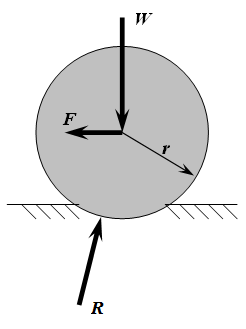

Force of the wheel normal to ground = Fnormal
Rolling friction coefficient = Croll
Rolling friction force = Froll = Croll Fnormal
Typical car tires have a rolling drag coefficient of .01 and specialized tires
can achieve lower values.
Croll
Railroad .00035 Steel wheels on steel rails
Steel ball bearings on steel .00125
Racing bicycle tires .0025 8 bars of pressure
Typical bicycle tires .004
18-wheeler truck tires .005
Best car tires .0075
Typical car tires .01
Car tires on sand .3
Wheel diameter = D
Wheel sinkage depth = Z
Rolling coefficient = Croll ≈ (Z/D)½


1672 Newton is the first to note the Magnus effect while observing tennis players
at Cambridge College.
1742 Robins, a British mathematician and ballistics researcher, explains deviations
in musket ball trajectories in terms of the Magnus effect.
1852 The German physicist Magnus describes the Magnus effect.
For a spinning tennis ball,
Velocity = V = 55 m/s Swift groundstroke
Radius = R = .067 m
Area = Area = .0141 m2
Mass = M = .058 kg
Spin number = S = W R / V = .25 Heavy topspin
Spin rate = W = V / R = 205 Hz
Air density = Dair = 1.22 kg/m3
Ball density= Dball
Drag coef = Cdrag = .5 For a sphere
Spin coef = Cspin = 1 For a sphere and for S < .25
Drag force = Fdrag = ½ Cdrag Dair Area V2 = 13.0 Newtons
Spin force = Fspin = ½ Cspin Dair Area V2 S = 6.5 Newtons
Drag accel = Adrag = 224 m/s2
Spin accel = Aspin = 112 m/s2
Gravity = Fgrav = M g
For a rolling ball the spin number is S=1.
V2 S C R-1 Dair/Dball = .0383
Car mass = M = 1200 kg
Gravity constant = g = 9.8 m/s2
Tire rolling drag coeff = Cr =.0075
Rolling drag force = Fr = Cr M g = 88 Newtons
Air drag coefficient = Ca = .25
Air density = D = 1.22 kg/meter3
Air drag cross-section = A = 2.0 m2
Car velocity = V = 17 m/s (City speed. 38 mph)
Air drag force = Fa = ½CaADV2 = 88 Newtons
Total drag force = F = Fr + Fa = 176 Newtons
Drag speed = Vd = 17 m/s Speed for which air drag equals rolling drag
Car electrical efficiency = Q = .80
Battery energy = E = 60 MJoules
Work done from drag = EQ = F X = Cr M g [1 + (V/Vd)2] X
Range = X = EQ/(CrMg)/[1+(V/Vd)2] = 272 km
The range is determined by equating the work from drag with the energy delivered
by the battery. E Q = F X.
Drag speed = Vd = [Cr M g / (½ Ca D A)]½ = 4.01 [Cr M /(Ca A)]½ = 17.0 meters/second


m/s Mach
Swim 2.39
Boat, human power 5.14
Aircraft, human power 12.3
Run 12.4
Boat, wind power 18.2
Bike 22.9
Car, solar power 24.7
Bike, streamlined 38.7
Land animal 33 Cheetah
Bird, level flight 45 White-throated needletail
Aircraft, electric 69
Helicopter 111 .33
Train, wheels 160 .54
Train, maglev 168 .57
Aircraft, propeller 242 .82
Rocket sled, manned 282 .96
Aircraft, manned 981 3.33
Rocket plane, manned 2016 6.83
Rocket sled 2868 9.7
Scramjet 5901 20
Mach 1 = 295 m/s at high altitude.
Mach
X-15 6.7 Rocket
Blackbird SR-71 3.5
X-2 Starbuster 3.2
MiG-25 Foxbat 2.83
XB-70 Valkyrie 3.0
MiG-31 Foxhound 2.83
F-15 Eagle 2.5
Aardvark F-111 2.5 Bomber
Sukhoi SU-27 2.35
F-22 Raptor 2.25 Fastest stealth aircraft




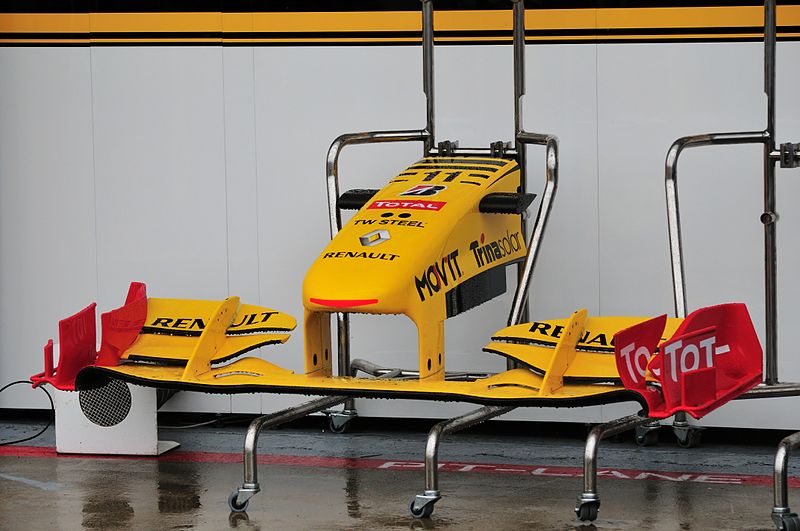
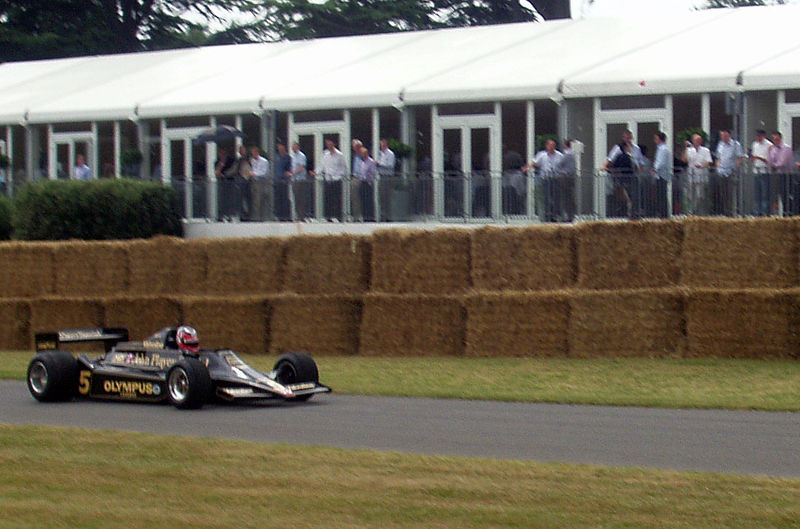
Car minimum mass = 702 kg Includes the driver and not the fuel
Engine volume = 1.6 litres Turbocharged. 2 energy recovery systems allowed
Energy recovery max power = 120 kWatts
Energy recovery max energy = 2 Megajoules/lap
Engine typical power = 670 kWatts = 900 horsepower
Engine cylinders = 6
Engine max frequency = 15000 RPM
Engine intake = 450 litres/second
Fuel consumption = .75 litres/km
Fuel maximum = 150 litres
Forward gears = 8
Reverse gears = 1
Gear shift time = .05 seconds
Lateral accelertion = 6 g's
Formula1 1g downforce speed= 128 km/h Speed for which the downforce is 1 g
Formula1 2g downforce speed= 190 km/h Speed for which the downforce is 2 g
Indycar 1g downforce speed = 190 km/h
Rear tire max width = 380 mm
Front tire max width = 245 mm
Tire life = 300 km
Brake max temperature = 1000 Celsius
Deceleration from 100 to 0 kph = 15 meters
Deceleration from 200 to 0 kph = 65 meters (2.9 seconds)
Time to 100 kph = 2.4 seconds
Time to 200 kph = 4.4 seconds
Time to 300 kph = 8.4 seconds
Max forward acceleration = 1.45 g
Max breaking acceleration = 6 g
Max lateral acceleration = 6 g
Drag at 250 kph = 1 g
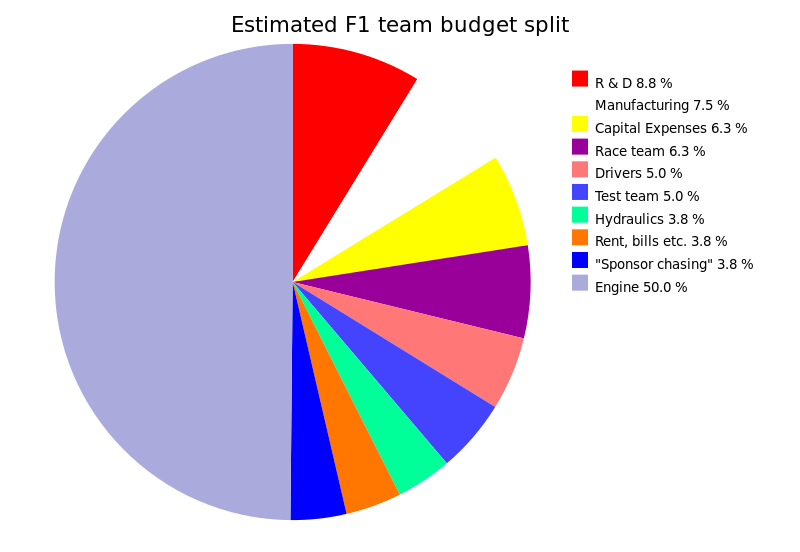
1950 Formula-1 begins. Safety precautions were nonexistent and death was considered
an acceptable risk for winning races.
1958 Constructor's championship established
1958 First race won by a rear-engine car. Within 2 years all cars had rear engines.
1966 Aerodynamic features are required to be immobile (no air brakes).
1977 First turbocharged car.
1978 The Lotus 79 is introduced, which used ground effect to accelerate air
under the body of the car, generating downforce. It was also the first
instance of computer-aided design. It was unbeatable until the introduction
of the Brabham Fancar.
1978 The Brabham "Fancar" is introduced, which used a fan to extract air from
underneath the car and enhance downforce. It won the race decisively.
The rules committee judged it legal for the rest of the season but the
team diplomatically
Wiki
1982 Active suspension introduced.
1983 Ground effect banned. The car underside must be flat.
1983 Cars with more than 4 wheels banned.
1989 Turbochargers banned.
1993 Continuously variable transmission banned before it ever appears.
1994 Electronic performance-enhancing technology banned, such as active suspension,
traction control, launch control, anti-lock breaking, and 4-wheel steering.
(4-wheel steering was never implemented)
1999 Flexible wings banned.
2001 Traction control allowed because it was unpoliceable.
2001 Beryllium alloys in chassis or engines banned.
2002 Team orders banned after Rubens Barrichello hands victory to Michael
Schumacher at final corner of the Austrian Grand Prix.
2004 Automatic transmission banned.
2007 Tuned mass damper system banned.
2008 Traction control banned. All teams must use a standard electrontrol unit.
2009 Kinetic energy recovery systems allowed.
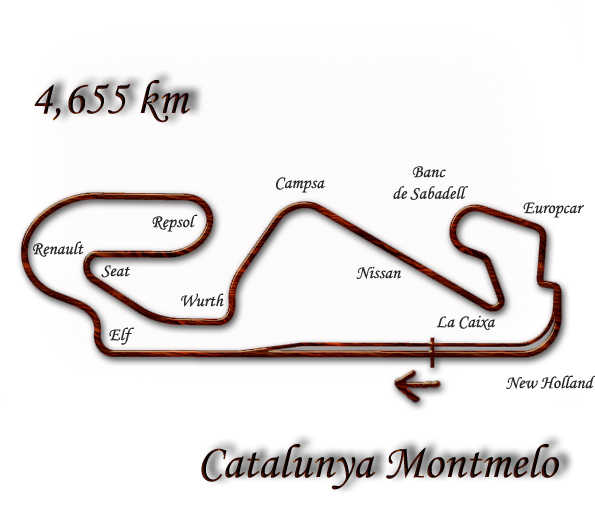
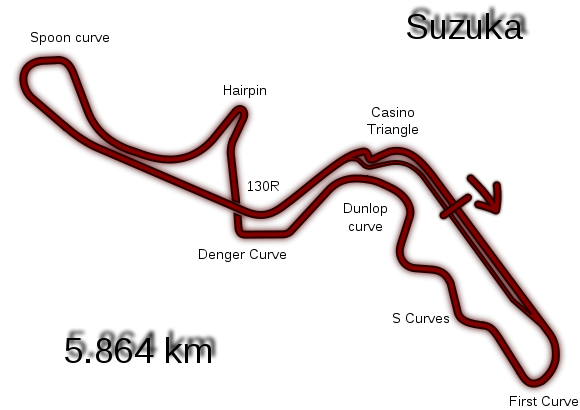
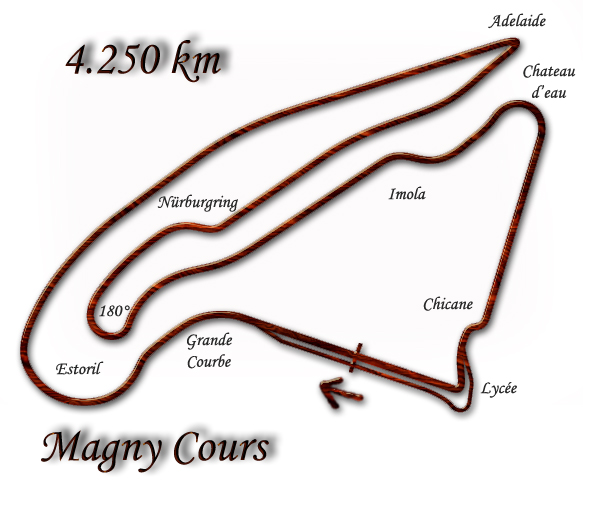
Place Points Place Points
1 25 6 8
2 18 7 6
3 15 8 4
4 12 9 2
5 10 10 1
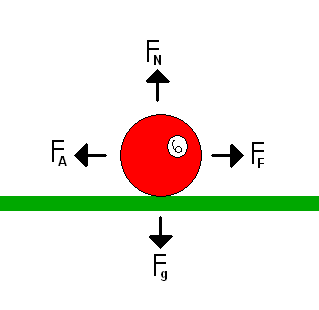
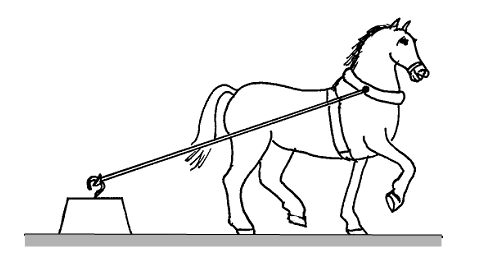
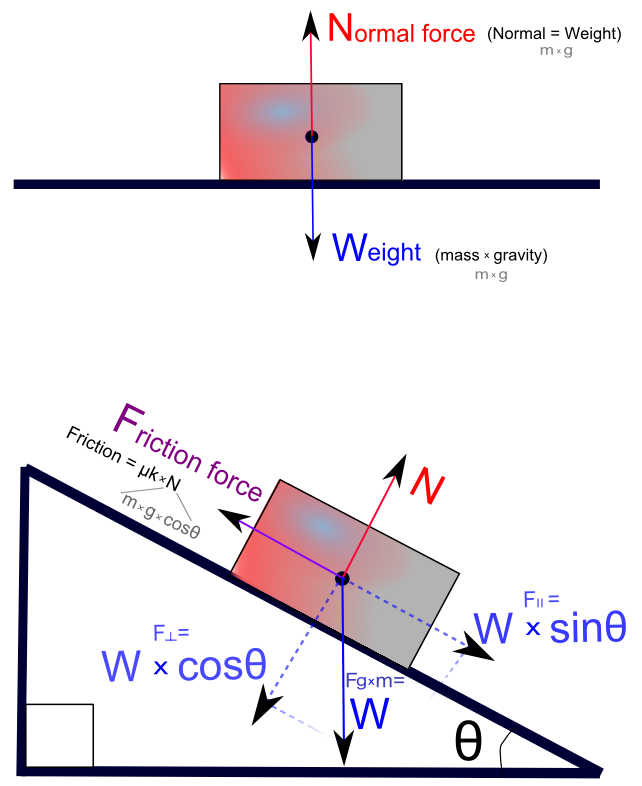
Fcontact = Contact force between the object and a surface (usually gravity)
Ffriction = Maximum friction force transverse to the surface of contact.
C = Coefficient of friction, usually with a magnitude of ~ 1.0.
Ffriction = C Fcontact
The larger the contact force the larger the maximum friction force.
Coefficient of friction
Ice .05
Tires 1
When two surfaces first come together there is an instant of large surface
force, which allows for a large friction force.
Agassi returning a Sampras serve. At T=0:07 Agassi's feet hit the ground
simultaneous with when he reads the serve.
Mass = M
Contact force between the car and the road = Fcontact = M g
Maximum friction force that the road can provide = Ffriction = C Fcontact
Maximum acceleration that friction can provide = A = Ffriction / M
= C Fcontact / M
= C g M / M
= C g
This clip shows the magnitude and direction of the acceleration while a Formula-1 car
navigates a racetrack.
Formula-1 lap
Maximum cornering acceleration = C g
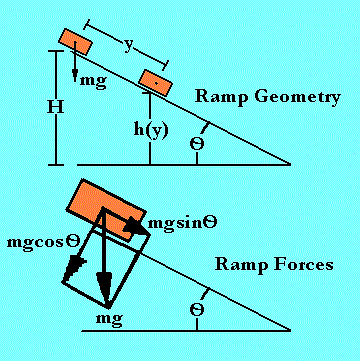
F = m g
The force between the object and the surface is equal to the
component of the gravitational force perpendicular to the surface.
Fcontact = Fgrav * cos()
The force of gravity parallel to the ramp surface is
Framp = Fgrav sin()
Th maximum friction force that the ramp can exert is
Ffriction = C Fcontact
This is balanced by the gravitational force along the ramp
Ffriction = Framp
Fgrav sin() = C Fgrav cos()
C = tan()
This is a handy way to measure the coefficient of friction. Tilt the ramp until
the object slides and measure the angle.
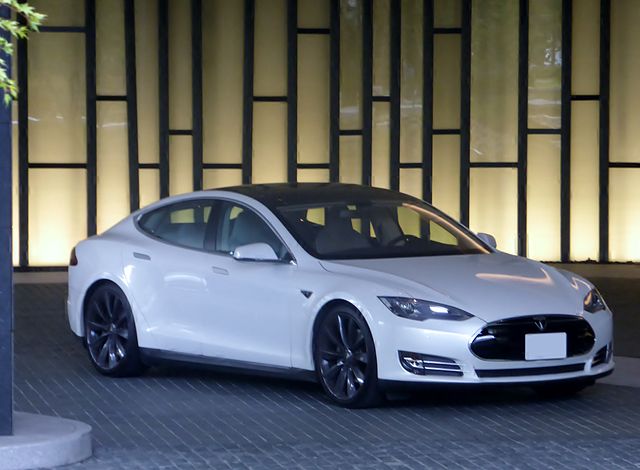
Battery energy/mass = e = .80 MJoules/kg
Battery power/mass = p = 1600 Watts/kg
Battery energy/$ = s = .010 MJoules/$
The range depends on the battery energy and the drag force. For a typical car,
Drag force = F = 120 Newtons (At a city speed of 15 m/s)
Battery energy = E = Joules
Range = X = E/F meters
For a typical car, the range per battery dollar is:
Battery mass = M = 100 kg
Battery energy = E = M e = 80 MJoules
Battery cost = S = E / s = 8000 $
Range = X = E / F = 670 km At a city speed of 15 m/s
Range/$ = x = X / S = .084 km/$
At a highway speed of 30 m/s the drag force is 3 times larger than at 15 m/s and the range
is 3 times less.
Cars outperform buses unless the bus is full.
Cars outperform bikes because they have a better drag coefficient.
Drag force = F
Distance = X
Energy expended = E
Number of people = N
Energy/distance/person = Z = E/X/N = F/N
Force/person Force/person Mass Cd Area Cr Drag People
at 15 m/s at 30 m/s speed
Newtons Newtons kg m2 m/s
Electric bike 99 387 20 1.0 .7 .004 2.6 1
Electric car 105 269 600 .3 2.0 .0075 14.3 1
Bus 23.1 56 10000 .6 8.0 .005 15.7 60
Subway car 9.7 34 34000 .6 10.0 .00035 6.3 100
Air drag cross section = A
Air drag coefficient = Cd
Rolling drag coefficient = Cd
We assume that each person adds 80 kg to the mass of the vehicle.
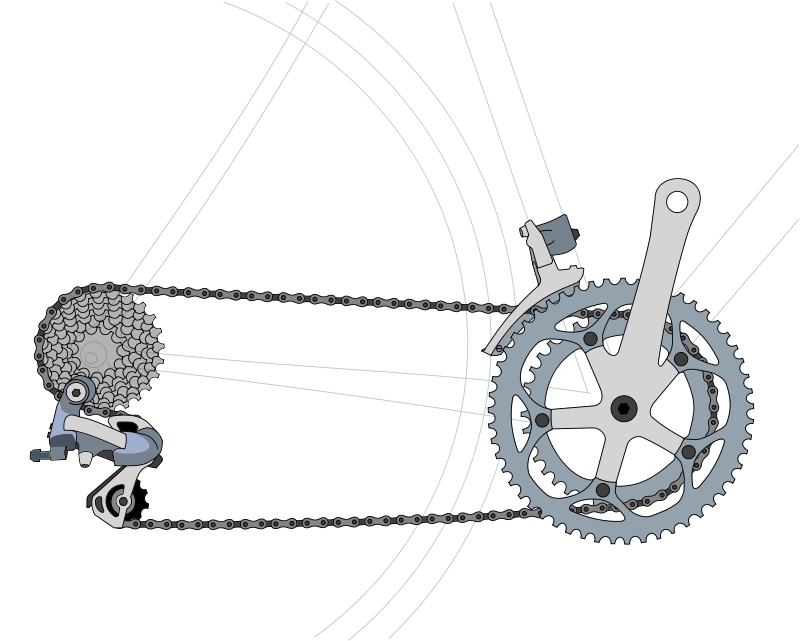
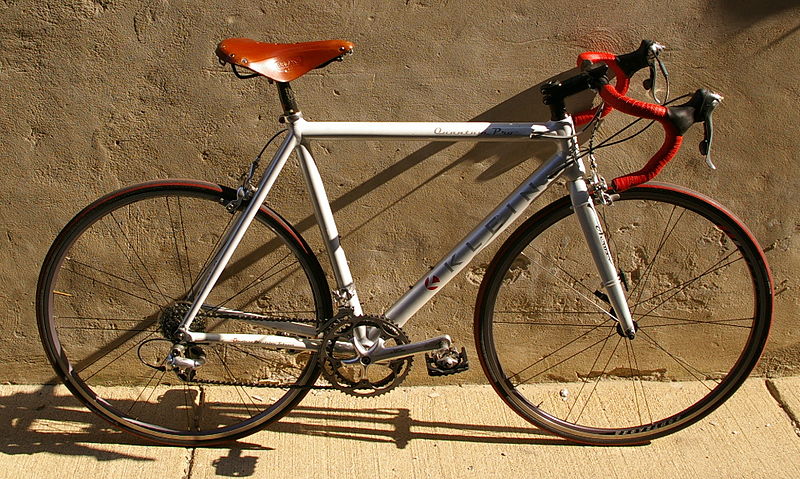
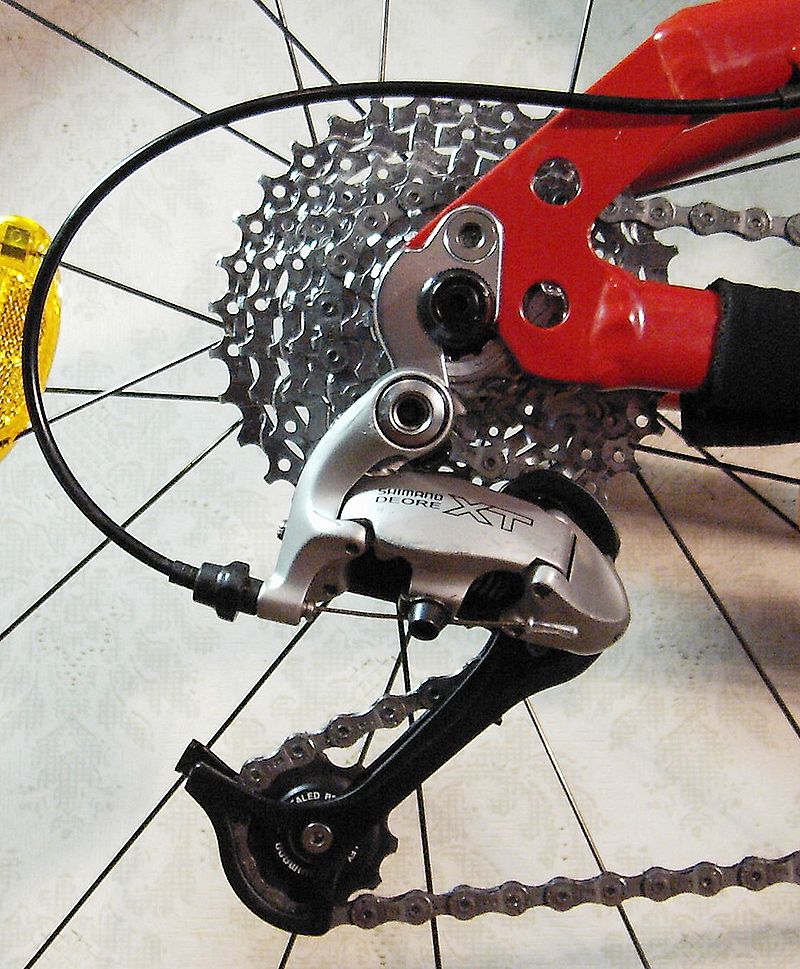
Velocity = V = 20 m/s (World record=22.9 m/s)
Power = P = 2560 Watts (Typical power required to move at 20 m/s, measured experimentally)
Force on ground = F = P/V = 128 Newtons

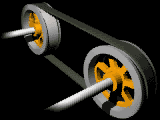

Number of links in the front gear = Nf = 53
Number of links in the rear gear = Nr = 11
Length of one link of a bicycle chain = L = .0127 m = .5 inches
Radius of the front gear = Rf = Nf L / (2 π) = .107 m
Radius of the rear gear = Rr = Nr L / (2 π) = .0222 m
Torque balance:
Ground force * Wheel radius = Chain force * Rear gear radius
Pedal force * Pedal radius = Chain force * Front gear radius
Chain force = Ground force * Wheel radius / Rear gear radius
= 128 * .311 / .0222
= 1793 Newtons
Pedal force = Ground force * Wheel radius / Pedal radius * Front gear radius / Rear gear radius
= Ground force * Wheel radius / Pedal radius * Front gear teeth / Rear gear teeth
= 128 * .311 / .17 * 53 / 11
= 1128 Newtons
Radius Force Torque Gear
(m) (N) (Nm) teeth
Pedal crank .170 1128 191.9 -
Front gear .107 1793 191.9 53
Rear gear .0222 1793 39.8 11
Rear wheel .311 128 39.8 -
Wheel frequency = Velocity / (Radius * 2Pi)
= 20 / (.311 * 2)
= 10.2 Hertz
Pedal frequency = Wheel frequency * Rear gear teeth / Front gear teeth
= 10.2 * 53 / 11
= 2.12 Hertz
= 127 revolutions per minute
Humans can pedal effectively in the range from 60 rpm to 120 rpm. Gears allow one to
choose the pedal frequency. There is also a maximum pedal force of around 1200 Newtons.
Pedal period * Rear gear teeth = Wheel period * Front gear teeth
Pedal radius / Pedal velocity * Front gear teeth = Wheel radius / Wheel velocity * Front gear teeth
Pedal force = Power / Pedal velocity
= Power / Wheel velocity * Wheel radius / Pedal radius * Front gear teeth / Rear gear teeth
= Power / Wheel velocity * .311 / .17 * Front gear teeth / Rear gear teeth
= Power / Wheel velocity * 1.83 * (Front gear teeth / Rear gear teeth)
= Power / Wheel velocity * 1.83 * Gear ratio
Gear ratio = Front gear teeth / Rear gear teeth
For a given power and wheel velocity, the pedal force can be adjusted by adjusting the gear ratio.
Power = 1000 Watts
Velocity = 3 m/s
Front gear teeth = 34 (Typical for the lowest gear)
Rear gear teeth = 24 (Typical for the lowest gear)
Pedal force = Power / Wheel velocity * 1.83 * Front gear teeth / Rear gear teeth
= 1000 / 3 * 1.83 * 34 / 24
= 864 Newtons
= 88 kg equivalent force
This is a practical force. If you used the high gear,
Pedal force = Power / Wheel velocity * 1.83 * Front gear teeth / Rear gear teeth
= 1000 / 3 * 1.83 * 53 / 11
= 2939 Newtons
= 300 kg equivalent force
This force is impractically high.

© Jason Maron, all rights reserved.
Data from Wikipedia unless otherwise specified.